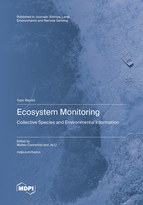Topic Menu
► Topic MenuTopic Editors

Ecosystem Monitoring: Collective Species and Environmental Information

A printed edition is available here.
Topic Information
Dear Colleagues,
Ecosystem monitoring is an increasingly important element for sensing ecosystem shifts, and for ecosystem management aiming to preserve ecosystem function and associated services under anthropogenic pressures. This Topic focuses on ecosystem monitoring considering ecological indicators of species and communities (particularly related to collective dynamics and its organization, e.g., via entropy characterization), environmental indicators such as water–soil–air features and their disturbance, as well as the nexus between ecological and environmental dynamics to understand their linkage and anticipate and control ecosystem shifts via nature-based solutions. Emphasis is also placed on technological innovation related to novel sensors, ecosystem monitoring networks, multiscale data (phenotypical, phylogenetic, eDNA, macroecological, etc.), data fusion, pattern analysis, and inference models for extraction of salient predictive information and ecosystem engineering (ecological and environmental engineering). Preference is given to aquatic ecosystems (rivers, lakes, oceans, etc.) and their linkage (e.g., land–ocean interface), but more broadly to any ecosystem where climatic and social feedback can be considered, such as alteration of carbon fluxes, health and economic impacts.
Dr. Matteo Convertino
Dr. Jie Li
Topic Editors
Keywords
- biodiversity
- ecosystems
- environment
- ecology
- monitoring
- sensing
- models
- predictions
- information
- networks
- collective
- dynamics
Participating Journals
| Journal Name | Impact Factor | CiteScore | Launched Year | First Decision (median) | APC |
|---|---|---|---|---|---|

Entropy
|
2.7 | 4.7 | 1999 | 20.8 Days | CHF 2600 |

Land
|
3.9 | 3.7 | 2012 | 14.8 Days | CHF 2600 |

Environments
|
3.7 | 5.9 | 2014 | 23.7 Days | CHF 1800 |

Remote Sensing
|
5.0 | 7.9 | 2009 | 23 Days | CHF 2700 |

MDPI Topics is cooperating with Preprints.org and has built a direct connection between MDPI journals and Preprints.org. Authors are encouraged to enjoy the benefits by posting a preprint at Preprints.org prior to publication:
- Immediately share your ideas ahead of publication and establish your research priority;
- Protect your idea from being stolen with this time-stamped preprint article;
- Enhance the exposure and impact of your research;
- Receive feedback from your peers in advance;
- Have it indexed in Web of Science (Preprint Citation Index), Google Scholar, Crossref, SHARE, PrePubMed, Scilit and Europe PMC.


